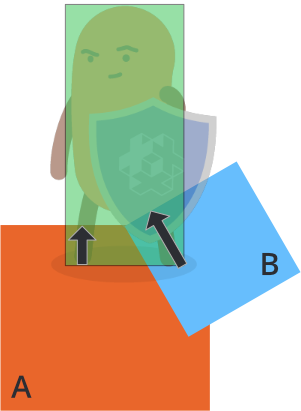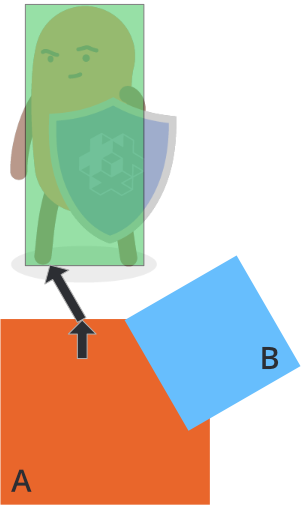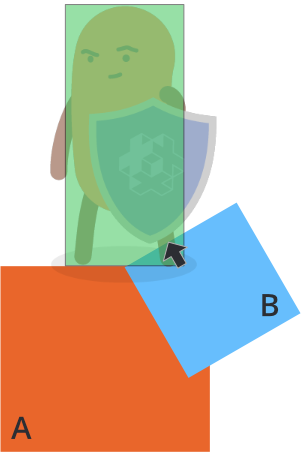This translation is community contributed and may not be up to date. We only maintain the English version of the documentation. Read this manual in English
解决运动学碰撞
使用运动学碰撞对象需要您自己解决碰撞并作为反应移动对象。一个简单的分离两个碰撞对象的实现看起来像这样:
function on_message(self, message_id, message, sender)
-- 处理碰撞
if message_id == hash("contact_point_response") then
local newpos = go.get_position() + message.normal * message.distance
go.set_position(newpos)
end
end
此代码将使您的运动学对象与其穿透的其他物理对象分离,但分离通常会过冲,在许多情况下您会看到抖动。为了更好地理解这个问题,考虑以下情况,其中玩家角色与两个对象 A 和 B 发生碰撞:

物理引擎将在碰撞发生的帧中发送多个 "contact_point_response" 消息,一个用于对象 A,一个用于对象 B。如果您像上面的简单代码那样响应每个穿透移动角色,结果分离将是:
- 根据 A 的穿透距离将角色移出(黑色箭头)
- 根据 B 的穿透距离将角色移出(黑色箭头)
这些顺序是任意的,但结果都是一样的:总分离是 各个穿透向量之和:

为了正确地将角色与对象 A 和 B 分离,您需要处理每个接触点的穿透距离,并检查任何先前的分离是否已经完全或部分地解决了分离。
假设第一个接触点消息来自对象 A,并且您通过 A 的穿透向量将角色移出:

然后角色已经部分地与 B 分离。执行与对象 B 完全分离所需的最终补偿由上面的黑色箭头指示。补偿向量的长度可以通过将 A 的穿透向量投影到 B 的穿透向量上来计算:

l = vmath.project(A, B) * vmath.length(B)
通过将 B 的长度减少 l 可以找到补偿向量。要为任意数量的穿透计算这个,您可以通过每个接触点,从一个零长度的校正向量开始,在向量中累积必要的校正:
- 将当前校正投影到接触的穿透向量上。
- 计算穿透向量中剩余的补偿(根据上述公式)。
- 通过补偿向量移动对象。
- 将补偿添加到累积的校正中。
完整的实现看起来像这样:
function init(self)
-- 校正向量
self.correction = vmath.vector3()
end
function update(self, dt)
-- 重置校正
self.correction = vmath.vector3()
end
function on_message(self, message_id, message, sender)
-- 处理碰撞
if message_id == hash("contact_point_response") then
-- 获取移出碰撞所需的信息。我们可能会
-- 得到多个接触点,必须通过为这一帧累积一个
-- 校正向量来计算如何移出所有接触点:
if message.distance > 0 then
-- 首先,将累积的校正投影到
-- 穿透向量上
local proj = vmath.project(self.correction, message.normal * message.distance)
if proj < 1 then
-- 只关心不会过冲的投影。
local comp = (message.distance - message.distance * proj) * message.normal
-- 应用补偿
go.set_position(go.get_position() + comp)
-- 累积完成的校正
self.correction = self.correction + comp
end
end
end
end
- English
- 中文 (Chinese)
- Español (Spanish)
- Français (French)
- Νεοελληνική γλώσσα (Greek)
- Italiano (Italian)
- Język polski (Polish)
- Português (Portuguese)
- Русский (Russian)
- Українська (Ukranian)
Did you spot an error or do you have a suggestion? Please let us know on GitHub!
GITHUB